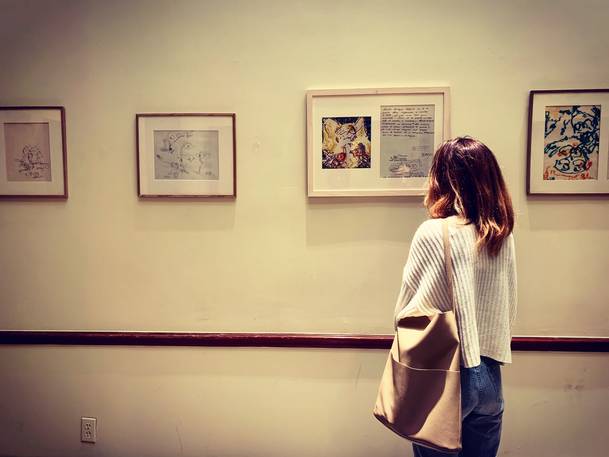


I’ll tell you a story that got me thinking on a day like many others.
Fall is approaching and life in New York begins to slowly pick up again for those who, like me, focus on the Italian presence in the City and in the United States. Summer tends to slow down Italian activities in New York. After the holidays, I then go back to visit my friends who share our publication’s mission to bring our culture to the attention of American audiences. The first among them is, and has been for years, Stefano Albertini, the Director of Casa Italiana Zerilli-Marimò.
The atmosphere there is vibrant as always, I am immediately offered a slice of cake to celebrate the birthday of one of the collaborators, Kostja Kostic. Then, I walk across two rooms to get to the director’s office.
They are in the midst of hanging an exhibition that inevitably grasps my attention. It consists of the drawings and writings of Carlo Levi. Many of them. With intense calm and precision, one man is positioning a series of frames that trace a rarely addressed narrative of the great author’s life.
Writer, painter, active antifascist, Carlo Levi [2] - most known throughout the world for Christ Stopped at Eboli [3], set in the region of Lucania - is a milestone in the global history of literature.
However, this story, which I learned walking around his works, brought me back to another southern Italian location: to Sicily, to San Pier Niceto, close to Milazzo. To the countryside, between the Peloritani mountains, among the smells of a land that is part of my family's history, surrounded by citrus fields, orchards, colorful vegetable gardens, almond trees, and mulberries.
Nino Sottile Zumbo is the name of the man hanging the exhibition. He’s a lawyer by trade but also, as I quickly learn, deeply passionate about art. We start talking. He doesn’t know I’m a journalist and begins his tale, with great passion and simplicity.
“These drawings and writings were in a barn near Milazzo!” he exclaims. He’s perfectly aware of having piqued my curiosity and continues:
“I walked passed the chickens and they were there, in the coop, between straw and hay. 145 drawings.” Made with pencil, ballpoint pen, pastel. They were made by Carlo Levi when he began to suffer from retinal detachment. During this time, he partially lost his vision and had to go through delicate surgical procedures.
But how did these drawings end up in Sicily? Here, we get to the story within the story, the one that ties Carlo Levi to the farmer Nino Milicia.
Nino Sottile Zumbo tells it, looking still incredulous himself as he speaks. It feels as if I’m watching a movie unfold. The images blend together, imagination mixes with reality.
Antonio Milicia is a Sicilian farmer who emigrated to Switzerland. There, he met Levi during a meeting for immigrants. The writer-painter, then a parliamentary, takes the stand and entrances him. “Farmers have a profound dignity because they carry the weight of the cross into their land,” this sentence was forever carved in the memory of the young Antonio Milicia. “He gave me dignity, he gave us peasants dignity.” Back in his homeland, he decides to buy an entire collection of his works.”
They remained in the dark for a long time. But their communicative power lies in a play of light and shadows, in a fascinating journey of the mind, traced by graphic marks and texts.
“Levi is a figurative artist - the lawyer-curator tells us - but he has the suggestive capacity of abstraction. I handle contemporary art and this brings me closer to these drawings.”
These drawings were created between light and darkness, during different phases of Levi’s illness, “They had built him a special instrument that allowed him to write and draw without seeing, made out of light wood, with a zipper that opened where the Pigna notebook paper went. It had little strings delineating his range of movement.” Within this cage, invisible to him, Levi searched for a tactile dimension through which to resurface the words and figures from his memory.
But as we know, the memory of the blind can often recall the details that we all fail to notice seeing.
For Nino Sottile Zumbo this was a deeply emotional experience: “He quizzed me on the life of Levi when we met. He wanted to make sure I was the right person, but eventually we became friends.”
“Antonio Milicia couldn’t receive a formal education, but he has a profound intellectual dimension within him,” he fervently proclaims.
And, after our conservation, I can’t help but think of Teresa Bellanova, our new Minister of Agriculture, attacked for not having a college education and wearing the wrong clothes, targeted especially on social media before even starting. She too labored on the fields, then becoming a trade unionist, showcasing both strength and sensibility. My most sincere wishes go out to the farmer Antonio Milicia, to Teresa Bellanova, and to this wonderful exhibition.
There are different types of blindness, unfortunately.
---
Blind Visions
Carlo Levi's Disegni della Cecità
Curated by Nino Sottile Zumbo
With the participation of Antonino Milicia
On view through December 13
Mon-Fri 10-6
Source URL: http://newsite.iitaly.org/magazine/focus/art-culture/article/beyond-blindness
Links
[1] http://newsite.iitaly.org/files/primolevicoverjpg
[2] https://en.wikipedia.org/wiki/Carlo_Levi
[3] https://en.wikipedia.org/wiki/Christ_Stopped_at_Eboli